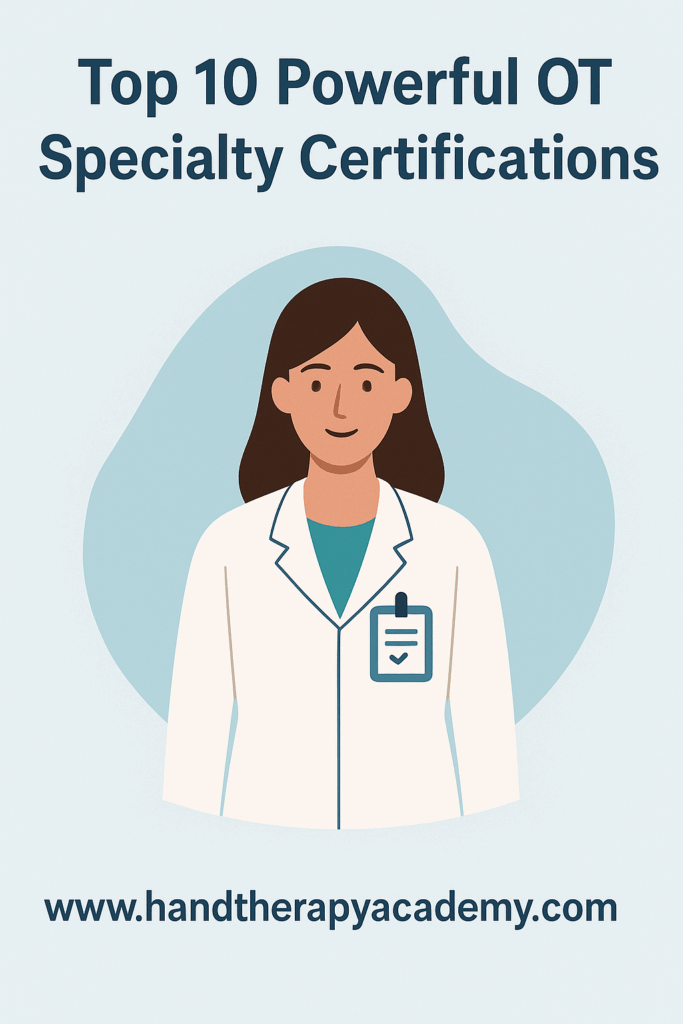Las 10 mejores certificaciones de especialidad en terapia ocupacional para impulsar tu carrera
archivado en Sin categoría
Introducción a las certificaciones especializadas en terapia ocupacional
La terapia ocupacional (TO) continúa expandiéndose hacia nuevos campos dinámicos y con ese crecimiento surge la necesidad de especializaciónYa sea que sea un terapeuta experimentado o recién esté comenzando, seguir Certificaciones de especialidad en terapia ocupacional Puede aumentar significativamente su experiencia y sus oportunidades laborales.
A medida que la atención médica se vuelve más compleja en 2025, los empleadores valoran cada vez más a los terapeutas que se esfuerzan al máximo obteniendo certificaciones en áreas específicas. Desde pediatría hasta rehabilitación física, estas credenciales pueden ser un punto de inflexión para su desarrollo profesional y un impacto positivo en la atención al paciente.

Beneficios de obtener una certificación de especialidad en terapia ocupacional
Exploremos por qué miles de terapeutas están agregando certificaciones de TO a su currículum:
- Experiencia avanzada: Obtendrá conocimientos profundos en un área especializada, mejorando su capacidad para tratar afecciones complejas.
- Movilidad profesional: Los terapeutas ocupacionales certificados a menudo acceden a roles de liderazgo, mercados laborales especializados y oportunidades de práctica privada.
- Confianza del paciente: Las certificaciones pueden indicar una mayor competencia y ganarse la confianza de los pacientes y de los equipos interdisciplinarios.
- Incentivos financieros: Muchos terapeutas ocupacionales certificados informan salarios más altos y mejores ofertas de trabajo.
- Reconocimiento Profesional: Destaque en su campo y contribuya a la investigación, las políticas y la enseñanza.
Descripción general de los organismos de certificación para OT
Varios organismos autorizados supervisan las certificaciones de especialidades en TO:
- Asociación Americana de Terapia Ocupacional (AOTA): Ofrece certificaciones en áreas como Pediatría, Gerontología, Salud Mental y más.
- Junta Nacional de Certificación en Terapia Ocupacional (NBCOT): Junta de acreditación principal para terapeutas ocupacionales en EE. UU.
- Sociedad de Ingeniería de Rehabilitación y Tecnología de Asistencia de Norteamérica (RESNA): Supervisa la certificación ATP.
- Academia de Terapeutas de Mano Certificados (ACHT): Administra la respetada credencial CHT.
Las 10 mejores certificaciones de especialidad en terapia ocupacional en 2025
Vamos a sumergirnos en el Las 10 mejores certificaciones de especialidades de terapia ocupacional que están dando forma al futuro de la terapia ocupacional.
1. Certificación de la Junta en Pediatría (BCP)
Esta certificación ayuda a los terapeutas ocupacionales a perfeccionar su experiencia en el tratamiento de bebés, niños y adolescentes. Abarca retrasos del desarrollo, trastornos del procesamiento sensorial e intervenciones escolares.
- Elegibilidad: 3 años de experiencia en TO con al menos 5,000 horas en pediatría.
- Mantenimiento: Renovación cada 5 años con formación continua.
2. Certificación de la Junta en Gerontología (BCG)
Perfecto para terapeutas que trabajan con adultos mayores, el BCG enfatiza la prevención de caídas, el cuidado de la demencia y las estrategias de envejecimiento en el lugar.
- Candidatos ideales: Terapeutas ocupacionales en hospitales, centros de rehabilitación o atención médica domiciliaria.
- Competencias básicas: Rehabilitación cognitiva, entrenamiento en AVD, apoyo a la movilidad.
3. Terapeuta de Mano Certificado (CHT)
Esta credencial conjunta para terapeutas ocupacionales y fisioterapeutas se centra en el tratamiento de lesiones de miembros superiores y la rehabilitación posquirúrgica.
- Requisitos: 4.000 horas de experiencia en terapia de manos + aprobar un examen riguroso.
4. Certificación de la Junta en Salud Mental (BCMH)
Esta certificación, de gran demanda, cubre enfoques terapéuticos para personas con enfermedades mentales, traumas y problemas de conducta.
- Áreas de práctica: Escuelas, psiquiatría hospitalaria, clínicas comunitarias.
5. Certificación de la Junta en Rehabilitación Física (BCPR)
Se centra en clientes con problemas neurológicos y ortopédicos, como accidentes cerebrovasculares, lesiones de la médula espinal y amputaciones.
- Conocimientos básicos: Neuroplasticidad, dispositivos de asistencia, entrenamiento funcional.
6. Terapeuta Certificado en Baja Visión (CLVT)
Dirigido a terapeutas que ayudan a los clientes con discapacidades visuales a maximizar su independencia utilizando herramientas y estrategias adaptativas.
- Entrenamiento cruzado: A menudo implica la colaboración con optometristas y oftalmólogos.
7. Profesional en Tecnología de Asistencia (ATP)
Ideal para terapeutas ocupacionales expertos en tecnología, la certificación ATP enfatiza el uso de herramientas y dispositivos digitales para apoyar a los clientes con discapacidades.
- Habilidades clave: Evaluación de dispositivos, personalización del sistema, integración de tecnología ética.
8. Especialista Certificado en Autismo (CAS)
Esta certificación apoya a los terapeutas que trabajan con personas en el espectro autista en todos los grupos de edad.
- Áreas de enfoque: Modulación sensorial, entrenamiento de habilidades sociales, intervenciones conductuales.
9. Certificación en Terapia del Linfedema
Ayuda a los terapeutas ocupacionales a controlar los trastornos de inflamación, especialmente después de tratamientos contra el cáncer, como las mastectomías.
- Técnicas de tratamiento: Drenaje linfático manual, compresión, cuidado de la piel.
10. Certificación en Tratamiento del Neurodesarrollo (NDT)
La NDT, especializada en trastornos neurológicos, es común en entornos de rehabilitación tanto pediátricos como de adultos.
- Acercarse: Holístico, práctico y centrado en restaurar la función a través del movimiento.
Cómo elegir la certificación de especialidad en terapia ocupacional adecuada
Con tantas certificaciones atractivas disponibles, es esencial seleccionar estratégicamente el indicado que se alinee con tus objetivos y pasiones a largo plazo. Aquí te explicamos cómo reducirlo:
1. Autoevaluación
- ¿Con qué poblaciones te gusta trabajar?
- ¿Es usted más clínico, centrado en la investigación o impulsado por la tecnología?
- ¿Disfruta de los entornos hospitalarios, escolares o de la atención médica domiciliaria?
2. Demanda del mercado
Investiga las ofertas de empleo en tu región. Certificaciones en salud mental, geriatría, y terapia de manos Suelen tener una gran demanda debido al envejecimiento de la población y las tendencias de atención post-aguda.
3. Metas profesionales
Si su objetivo es especializarse, abrir una consulta privada o dedicarse a la docencia, obtener una certificación puede ser un paso crucial. Para puestos tecnológicos avanzados, considere ATP. Para puestos de liderazgo, considere BCP o BCG.
4. Inversión financiera
Algunas certificaciones son más costosas o requieren más tiempo que otras. Evalúe el retorno de la inversión (ROI): ¿Esta certificación le proporcionará aumentos salariales, mejores puestos o satisfacción personal?
Proceso de certificación: paso a paso
Ya sea que esté solicitando su primera o tercera certificación de especialidad, el proceso generalmente sigue estos pasos:
1. Cumplir con los requisitos de elegibilidad
- La mayoría requiere al menos 3 años de experiencia y más de 5000 horas en el área de especialidad.
- Debe tener una licencia de OT actual y activa.
2. Presentar solicitud
- Las solicitudes generalmente implican presentaciones de estudios de casos, referencias profesionales y documentación de horas clínicas.
- Espere pagar una tarifa de solicitud que varía entre $350–$650.
3. Prepárese para los exámenes (si corresponde)
- Utilice guías de estudio oficiales, grupos de pares o unidades de educación continua (CEU) para prepararse.
- Algunas certificaciones (como CHT) requieren un examen estandarizado, mientras que otras (como las certificaciones de la junta AOTA) utilizan una revisión de portafolio.
4. Certificación otorgada
- Una vez aprobado, recibirá su designación oficial y su listado en una base de datos nacional.
- Esto puede aumentar su visibilidad ante empleadores y clientes.
5. Mantener y renovar
- La mayoría de las certificaciones son válidas para 5 años.
- Debes completar la educación continua y, a veces, volver a presentar un portafolio o volver a realizar el examen.
Oportunidades profesionales después de la certificación
Con la certificación en la mano, las puertas se abren en numerosas direcciones:
| Configuración | Roles |
| Hospitales | Terapeuta senior, especialista en rehabilitación |
| Escuelas | Especialista en autismo, Coordinador del programa |
| Clínicas | Cable para baja visión o terapia de mano |
| Academia | Instructor de terapia ocupacional, investigador asociado |
| Práctica privada | Consultor independiente, profesional en END |
En términos de salario, muchos terapeutas certificados informan un aumento anual de $5,000–$15,000, dependiendo de la configuración y la región.
Mitos comunes sobre las certificaciones especializadas en terapia ocupacional
Vamos a desmentir algunos mitos que podrían estar frenándote:
- “Son sólo para recién graduados”. ¡Falso! Muchos terapeutas de mediana y avanzada carrera buscan certificaciones para cambiar de profesión o especializarse.
- “Demasiado caro y consume mucho tiempo”. – El retorno de la inversión (ROI) en conocimiento, credibilidad y remuneración a menudo justifica el costo.
- “Tienes que ser un genio.” – No es cierto. Estas certificaciones se basan en tu experiencia clínica en el mundo real.
- “No ayudará a mi carrera”. – Por el contrario, muchos terapeutas utilizan certificaciones para Transición a roles de liderazgo o de nicho.
Preguntas frecuentes sobre las certificaciones de especialidad en terapia ocupacional
1. ¿Necesito una certificación de especialidad para practicar TO?
No. La licencia es un requisito legal. Las certificaciones son voluntarias, pero muy beneficiosas para la especialización y el desarrollo profesional.
2. ¿Cuánto tiempo se tarda en obtener una certificación?
La mayoría de los terapeutas pasan 3–6 meses preparándose, dependiendo de la certificación y su nivel de experiencia.
3. ¿Puedo tener varias certificaciones?
¡Por supuesto! Muchos terapeutas cuentan con dos o más certificaciones, como CHT y ATP, para diversificar su práctica.
4. ¿Qué pasa si dejo caducar mi certificación?
Es posible que necesites volver a aplicar o volver a realizar la prueba, dependiendo del organismo certificador. Algunos permiten períodos de gracia con penalizaciones.
5. ¿Existen cursos en línea que puedan ayudarme a prepararme?
¡Sí! Hand Therapy Academy ofrece diferentes opciones para tu carrera.
6. ¿La certificación hará una gran diferencia en mi currículum?
Sí. Te distingue de otros candidatos y demuestra compromiso con el aprendizaje permanente y la excelencia clínica.
Conclusión: El futuro de la terapia ocupacional especializada
El campo de la terapia ocupacional se vuelve cada año más matizado y multifacético. Certificaciones de especialidad en terapia ocupacional Capacitar a los profesionales para que se mantengan a la vanguardia, sirvan mejor a los clientes y disfruten de carreras profesionales satisfactorias.
A medida que la atención médica continúa demandando atención especializada, los terapeutas ocupacionales certificados liderarán el camino con innovación, compasión y credibilidad. Si te apasiona la neurorehabilitación, la pediatría o la tecnología de asistencia, existe una certificación que se adapta a tu vocación. Así que no esperes.Invierta en su crecimiento, credibilidad e impacto ¡hoy!
Más para leer
Ejercicio terapéutico versus actividad terapéutica
¿Cuál es la diferencia entre ejercicio terapéutico versus actividad terapéutica? El ejercicio terapéutico se factura como 97110 y la actividad terapéutica se factura como 97530. Ambos son códigos CPT que se utilizan comúnmente en la facturación de fisioterapia y ocupacional. Estos códigos son muy similares y a menudo se confunden. Entonces, ¿cuándo y qué documentas para cada...?
Leer másEfectos de diferentes técnicas de estiramiento para mejorar el rango de movimiento articular.
Referencia: Oba, K., Samukawa, M., Abe, Y., Suzuki, Y., Komatsuzaki, M., Kasahara, S., Ishida, T. y Tohyama, H. (2021). Efectos del estiramiento estático intermitente y continuo sobre el rango de movimiento y las propiedades viscoelásticas musculotendinosas según un protocolo de duración equivalente. Revista internacional de investigación ambiental y salud pública, 18(20), 10632. https://doi-org.libproxy.nau.edu/10.3390/ijerph182010632 The Skinny: Este estudio utilizó un cruce…
Leer másEficacia de la rehabilitación con realidad virtual tras una lesión de la médula espinal: una revisión sistemática
De Araújo, AVL, Neiva, JFDO, Monteiro, CBDM y Magalhães, FH (2019). Eficacia de la rehabilitación con realidad virtual después de una lesión de la médula espinal: una revisión sistemática. BioMed Research International, 2019(1), 7106951. https://doi.org/10.1155/2019/7106951 Eficacia de la rehabilitación con realidad virtual después de una lesión de la médula espinal Emilee Sanders, OTS The Skinny: La realidad virtual (RV)…
Leer másPoniendo la ocupación en la terapia de manos
Fue al comienzo de mi carrera, tal vez un año después de haber terminado la escuela. Estaba trabajando con un fisioterapeuta veterano que había ejercido durante más de treinta años. Era algo intimidante y una de esas fisioterapeutas de la vieja escuela a las que les encantaba ser agresivas. Estuvimos charlando sobre qué áreas de la terapia ocupacional de manos…
Leer más¡Regístrese para recibir actualizaciones directamente en su bandeja de entrada!
Regístrese con nosotros y le enviaremos publicaciones periódicas en el blog sobre todo lo relacionado con la terapia de manos, avisos cada vez que subamos nuevos videos y tutoriales, junto con folletos, protocolos y otra información útil.






